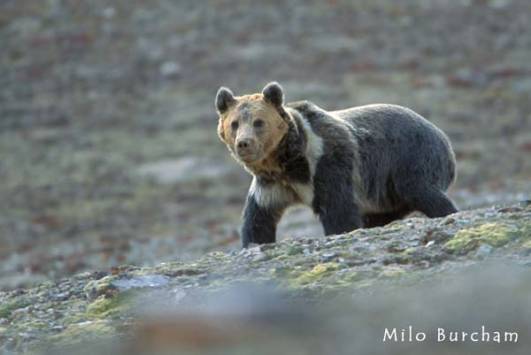The territories of the American black bear (Ursus americanus) and grizzly bear (Ursus arctos horribilis) overlap, and knowledge of the species' differences may save your life.
There are three telltale physical characteristics used to distinguish a grizzly from a black bear: a prominent hump between the front shoulders, long front claws, and the shape of the head.
Most adult grizzlies have a prominent hump of muscle mass between their front shoulders. Black bears lack a distinct hump. The long front claws of a grizzly can be difficult to see. The claws of an adult can be longer than a human's fingers. Black bear claws are generally only 2-3 inches long.
A grizzly has a flatter, dish-shaped face than a black bear's prominent, dog-like profile. A grizzly's forehead is usually concave; a black bear's face is straight and long, and from the front, the face and forehead appear round. Fur color and size are not good methods for identification. Grizzlies may be any shade of brown, from blond to nearly black. Some have silver-tipped fur. Black bears, despite their name, are rarely black, and can be brown, cinnamon-red, or blond.
A full-grown black bear can weigh 100 to 300 pounds, while an adult grizzly weighs 200 to 700 pounds. So size is not a good indicator of the species.Black bears are primarily adapted to forested areas and their edges and to clearings. Grizzlies make much more use of large, non-forested meadows and valleys.Behaviorally, black bears are generally much less aggressive than grizzlies, often climbing trees to escape perceived threats. Grizzlies are more aggressive than black bears and much more likely to attack.
There are three telltale physical characteristics used to distinguish a grizzly from a black bear: a prominent hump between the front shoulders, long front claws, and the shape of the head.
Most adult grizzlies have a prominent hump of muscle mass between their front shoulders. Black bears lack a distinct hump. The long front claws of a grizzly can be difficult to see. The claws of an adult can be longer than a human's fingers. Black bear claws are generally only 2-3 inches long.
A grizzly has a flatter, dish-shaped face than a black bear's prominent, dog-like profile. A grizzly's forehead is usually concave; a black bear's face is straight and long, and from the front, the face and forehead appear round. Fur color and size are not good methods for identification. Grizzlies may be any shade of brown, from blond to nearly black. Some have silver-tipped fur. Black bears, despite their name, are rarely black, and can be brown, cinnamon-red, or blond.
A full-grown black bear can weigh 100 to 300 pounds, while an adult grizzly weighs 200 to 700 pounds. So size is not a good indicator of the species.Black bears are primarily adapted to forested areas and their edges and to clearings. Grizzlies make much more use of large, non-forested meadows and valleys.Behaviorally, black bears are generally much less aggressive than grizzlies, often climbing trees to escape perceived threats. Grizzlies are more aggressive than black bears and much more likely to attack.



